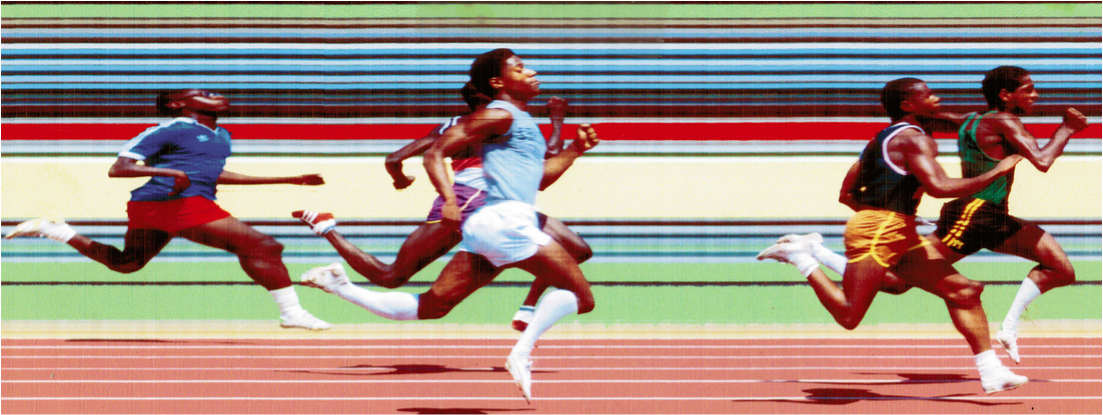I always challenge my students to learn as much about the technical side of photography, mainly physics, as they grow their skills. The more you know how it all works, the easier it is to use you equipment and light to make both interesting and dramatic photos.
One idea that intrigued me early in my photographic career, was the "finish-line camera" and photo-finish photography. This type of photography, invented in the 1930’s; below is an explanation of its origins.
(1) “Historically, in the United States motion picture cameras had been used since the 20s for recording race-meets but were unsuitable for photo-finish photography as the frame-rate was too infrequent to catch the critical instant horses or dogs reached the finish-line. This record was achieved by using a special slit camera. Lorenzo Del Riccio, a Paramount Pictures motion picture engineer improved the circular flow camera, a device which had been invented in the 1930s especially for the purpose of photographing moving objects. The first racing club to make use of Del Riccio's 'Photo-Chart' camera for photo-finishes was the Del Mar Turf Club in California at its inaugural meeting in 1937.
Unlike conventional cameras the circular flow camera used a single vertical slit instead of a shutter; a strip of film moved horizontally across the fine vertical opening located in the focal plane. This limited the field of vision to no more than a few inches, the restricted field being aligned with the vertical line on the winning post on which the lens was focused. The strip film moved across the slit in the opposite direction to the race and at substantially the same speed as the rate of movement of the image of the horses as it passed the finishing line. This kept the image of the horses more or less stationary with respect to the film. As soon as the first horse started to pass over the line, the camera began to record its image on the moving film from the nose backwards along the length of the body in succession. This produced a strip photographic record of the horses as they passed the vertical plane (winning post). Film was advanced continuously at a pace equivalent to the average speed of a racing horse, resulting in distortions of length but still preserving the order of finishers.
Improvements were developed, including that made in 1948 by Australian Bertram Pearl whose system incorporated a mirror and neon-pulse time signature in the winning-post which would provide a precisely aligned image in which both sides of the horses could be viewed, and on which the neon left a set of stripes at 100th/sec intervals for accurate timing. If the reflected image of the horses aligned vertically exactly with the foreground image, it was proof that the camera was not viewing the finish-line at an angle (and therefore incorrectly recording the horses' relative positions). Pearl's partner was his friend, society portraitist Athol Shmith.[1] Shmith’s contribution was to formulate means to speed the processing of the strip of negative down to 55 seconds and then to a rapid 35 seconds.[2] These times rivalled even the ‘instant’ one-minute picture processing by Edwin Land’s Model 95 which became available at that time.”
Understanding the principal of how the slit and the moving film work together, I used some algebra and physics to create the effect using a professional film camera at a summer track meet when I worked at the Clarion Ledger and Daily News in Jackson, Mississippi.
Now, how did I do it? I understood that the film needed to pass by a slit as the runners were moving. I first took my Nikon F2 and recorded the average time it took the film to rewind in the camera (about 6 seconds). I then measured the length of the film (about 62 inches); in order to achieve an exposure calculation I needed the size of the slit (I chose 1/64 inch). Sixty-two inches times sixty-four is 3968 divided by six is approx. 668. Therefore I would be running the film past the slit at about 1/700 sec. In order to get a decent amount of depth of field I used a 50mm lens and chose f 5.6, which put me about ASA 200 on a sunny day (exposing the average for shadows and highlights). I didn’t like the 200 ASA slide film in those days so I used 100 ASA and pushed it one stop.
I used two pieces of opaque film I pickup from the guys in the back shop, cut them square and taped them 1/64 inch apart in the middle of the film plane. Next loaded the film and shot the whole roll with the lens cap on. Finally I focused the lens, set the camera shutter on “bulb,” and started the rewind process a second or two before the runners reached the finish line so that the film would be running a consistent speed.
If you try this, use some out of date film first as you test your exposure so as not to waste, then record your best results (practicing with different f-tops and slit sizes) and then shoot the "good" film.
Another tip: Since the background and anything else that is stationary will be captured as a blur, look for colorful backgrounds to use behind the area that the slit is capturing to create a more dramatic photo.
Good luck!
Mark
Reference:
1. http://en.wikipedia.org/wiki/Photo_finish


 RSS Feed
RSS Feed